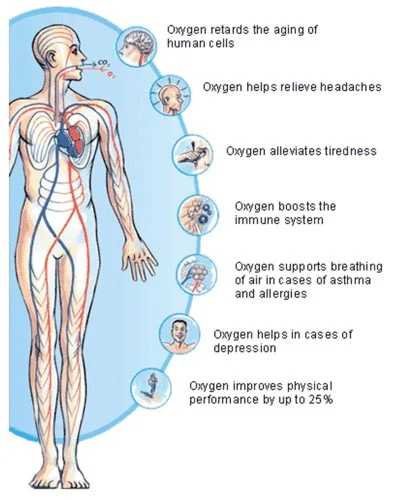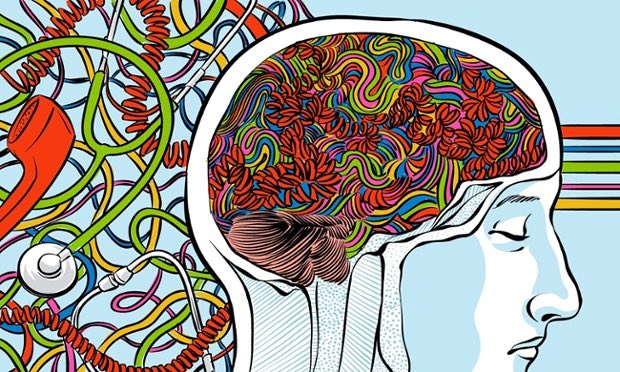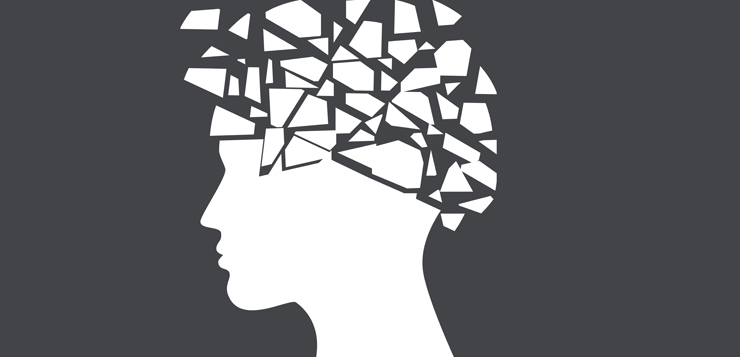“Insufficient oxygen means insufficient biological energy that can result in anything from mild fatigue to life threatening disease. The link between insufficient oxygen and disease has now been firmly established.”
Oxygen is absolutely essential for life, and your brain depends it more than any other part of your body.
Your brain weighs about 2% of your body weight.
But it consumes about 20% of the oxygen you breathe.
Your brain cells need to get enough oxygen to produce energy and function optimally.
If they don’t, they can start to deteriorate, leading to poor memory and concentration, low mood, lack of energy and drive.
I personally use oxygen therapy with an oxygen concentrator to support and optimize my brain function.
This post discusses oxygen therapy, the benefits, how I use it, and how it could help you.
It’s a great way to boost cognitive function, memory and energy.
Read on to learn more.
Types of Oxygen Therapy
Oxygen therapy is the use of supplemental oxygen to treat a variety of medical conditions.
Air is typically 21% oxygen by volume, but oxygen therapy increases the amount.
Hyperbaric oxygen therapy (HBOT) is the most well-known type of oxygen therapy, and it allows patients to inhale 100% pure oxygen in a total body chamber.
HBOT is often used by professional athletes for recovery and performance.
But it’s expensive and not available to most people.
Luckily, it’s not the only option available to you.
Normobaric oxygen therapy (NBOT) is much less expensive, and it’s easily accessible and non-invasive. I personally use NBOT at home.
Similar to HBOT, NBOT brings a higher percentage of oxygen into the body and can bring major benefits to your brain and cognition.
Researchers have found that both normobaric and hyperbaric oxygen therapy increase the amount of oxygen that is delivered to the blood and brain (1-2).
With normobaric therapy, oxygen can be delivered via an oxygen concentrator.
An oxygen concentrator is a machine that separates oxygen from room air, and then delivers the concentrated oxygen through a nasal cannula or mask.
I use this oxygen concentrator.
Make sure you read the “My Experience” section below where I discuss how to use it. .
Why You Might Need Oxygen Therapy and How It Works
Hypoxia is a condition in which the body or a region of the body is deprived of adequate oxygen supply.
If this happens to you, you can end up with mitochondria dysfunction and poor brain function.
But how do you know?
You can use an oxygen saturation monitor to measure and monitor your blood oxygenation levels. I use this monitor. It’s the best and most accurate oxygen saturation monitor that is often used by medical professionals, and freely available to the public.
Your blood oxygen saturation levels (SpO2) should measure 99-100% if you want to feel optimal.
There are a number of reasons why your body and brain might not be getting enough oxygen:
Sedentary lifestyle and lack of exercise
Shallow breathing – Most people today don’t breathe well and are shallow breathers.
Chronic stress – Stress and anxiety can also affect your breathing. If you're stressed and anxious, you end up taking more shallow breaths. Your sympathetic “fight or flight” nervous system is chronically active, and this reduces the amount of oxygen that reaches your brain.
Abnormal blood pressure – Both high and low blood pressure can be problematic and may suggest that blood is not optimally flowing to your brain. If blood flow to your brain is poor, oxygen levels in your brain will also be suboptimal.
Normobaric oxygen therapy can help you if you’re struggling with any of these problems.
It can also help if you’re recovering from a concussion or brain injury or some sort of toxic exposure (e.g. mold).
Neuroplasticity and neurogenesis require oxygen, and increasing the delivery of oxygen to the body and brain supports the healing process of damaged tissue.
Normobaric oxygen therapy has been shown to work by increasing brain blood flow, reducing permeability of the blood-brain barrier, and it may even have cholinergic properties (3-8).
Researchers have concluded that the “neuroprotective role of normobaric oxygen therapy is extremely promising” (9).
They have also found that it can lead to a number of positive cognitive outcomes, which I'll explore below.
1. Normobaric Oxygen Therapy Improves Memory and Recall
In their book Advances in Natural Medicines, Nutraceuticals, and Neurocognition, Dr. Andrew Scholey and Dr. Con Stough state that normobaric oxygen therapy is an effective memory enhancer:
“Research has shown that oxygen administration leads to improved long-term memory compared to a control group of normal air-breathing.”
Several clinical studies also show that concentrated oxygen significantly enhances memory formation and recall in adults (10-11, 16-17).
In one study, inhalation of oxygen immediately prior to learning a word list resulted in a significant increase in the average number of words recalled 10 minutes later (14).
In other studies, subjects who received oxygen remembered shopping lists and faces better than subjects that didn’t receive oxygen (12-13, 18).
Researchers have also found significant positive correlations between changes in oxygen saturation and memory performance (15).
2. Normobaric Oxygen Therapy Improves Cognitive Performance
Research shows that concentrated oxygen significantly enhances cognitive performance (19-20, 29).
And it doesn’t just improve cognitive function in the elderly; it also enhances cognitive processing in young adults (21-23).
In one study, students that inhaled oxygen while playing a computer game performed much better compared to students who didn’t inhale any additional oxygen (26).
In two other studies, researchers found that the inhalation of 30% oxygen improved cognitive functioning and performance by activating several brain areas (24-25).
“Oxygen administration appears to facilitate cognition most effectively for tasks with a higher cognitive load.”
They concluded that breathing a higher concentration of oxygen increases blood oxygen levels in the brain, which then supports cognition (24-25).
And other researchers have found significant correlations between blood oxygen levels and cognitive performance (27-28).
3. Normobaric Oxygen Therapy Enhances Accuracy
Several studies have found that normobaric oxygen therapy can also increase your accuracy when doing tasks.
Two studies found that 30% and 40% oxygen administration significantly enhanced accuracy rates compared to 21% oxygen (normal air). It did this by increasing oxygen levels in the blood, which then stimulated activity in the brain (31-32).
As the difficulty of the task increased, the difference in the accuracy rate between 40% and 21% oxygen administration also increased (33-34).
And researchers found a positive correlation between task performance and oxygen levels in the brain (33-34).
Other research has found that 30% oxygen administration enhances accuracy rates during verbal tasks by activating specific areas of the brain (35-36).
4. Normobaric Oxygen Therapy Reduces Reaction Time
People who receive normobaric oxygen therapy also have faster reaction times (37-38).
In one study, participants performed visual matching tasks under 43% oxygen or 21% oxygen (normal air).
Researchers reported a significant decrease in reaction time in the presence of 43% oxygen (39).
The researchers hypothesized that normobaric oxygen therapy increases oxygen levels in the blood, which then leads to more available oxygen in the brain (39).
Another follow-up study confirmed that response time decreases during normobaric oxygen therapy due to the increase in blood oxygen levels (40).
Normobaric oxygen therapy has even been shown to reduce reaction time in children with attention deficit hyperactivity disorder (ADHD) (41).
5. Normobaric Oxygen Therapy Increases Energy
“Despite comprising only 2 percent of the body’s weight, the brain gobbles up more than 20 percent of daily energy intake.”
All cells within your body need oxygen, particularly your brain cells.
They require a lot of oxygen to produce energy.
In fact, your energy levels depend on how much oxygen you have and how well your mitochondria utilize it.
If your brain doesn’t get enough oxygen, it simply won’t function properly, and you’ll end up feeling tired.
But normobaric oxygen therapy can increase energy.
Research shows that it "decreases fatigue and reduces feelings of sleepiness" (51).
6. Normobaric Oxygen Therapy Improves Neurological Function After Stroke
Researchers say that normobaric oxygen therapy is a promising therapy for stroke patients.
It’s been shown to reduce brain swelling and blood-brain barrier permeability and increase brain blood flow after stroke (42-43).
One study found that normobaric oxygen therapy significantly improved neurological functions in patients with acute ischemic stroke (44).
Other researchers have found that normobaric oxygen therapy increases oxygen supply to damaged tissues and improves outcomes after stroke, in both animals and humans (45-46).
As a non-pharmaceutical and non-invasive treatment, normobaric oxygen therapy is “worthy of notice” (47).
7. Oxygen Therapy May Help Reverse Brain Damage After Traumatic Brain Injury
Researchers found that a combination of normobaric and hyperbaric oxygen therapy reversed brain damage in 2-year-old girl who nearly drowned in a swimming pool.
She received normobaric oxygen treatment (twice daily for 45 minutes by nasal cannula), and doctors witnessed significant improvements in her neurological function (48-49).
Normobaric oxygen therapy alone improved the girl’s neurological function before she started hyperbaric oxygen therapy (48-49).
She eventually made a full recovery with both types of oxygen therapy.
Researchers have also said that the “neuroprotective role of normobaric oxygen therapy is extremely promising” for traumatic brain injury (50).
I’ve also seen multiple studies with rats and mice showing that normobaric oxygen therapy reduces brain swelling and brain damage.
8. Other Possible Benefits (with Less Research Behind Them)
Increases attention and vigilance – Oxygen administration significantly improved performance on several measures of attention and vigilance (52).
Reduces inflammation – Oxygen levels play a critical role in determining the severity of the inflammatory response and ultimately the effectiveness of anti-inflammatory drugs (53-54).
Improves hand-eye coordination (55).
Increases positive sense of wellbeing (56).
My Experience with Normobaric Oxygen Therapy
“If you use oxygen for 20 minutes, muscles become loosened, headaches and stress seem to disappear, there is a renewed energy and a feeling of relaxation.”
I was first introduced to oxygen therapy through an integrative doctor I know.
At the end of each appointment with him, I would use his oxygen concentrator for about 15-20 minutes. He used this oxygen concentrator.
I eventually decided to buy my own oxygen concentrator and now regularly use it at home.
I bought this oxygen concentrator. I'll discuss how it has helped me below.
The oxygen from the concentrator is supplied through an nasal canula. It’s completely non-invasive and painless, and it’s become one of my favourite tools for supporting my brain.
I use it for about 20 to 30 minutes, a few times each week. I often do this while exercising on this indoor stationary bike. Sometimes I use it without exercising on the bike.
I also use it for about 3 to 5 minutes as needed, usually when doing work.
During a session, I use this oxygen saturation monitor to measure my blood oxygenation levels.
Your blood oxygen saturation levels (SpO2) should measure 99-100%. I see mine increase and max out while using the concentrator.
My oxygen concentrator delivers up to 5 litres of oxygen per minute. I usually set mine somewhere between 3 and 5 litres per minute.
But I would recommend starting lower and working your way up.
Similar to low-level laser/light therapy, oxygen therapy is somewhat experimental. You need to find the right “dosage” for yourself.
Benefits and What I’ve Noticed
I've had good results with concentrated oxygen therapy and it has surprisingly increased the quality of my life.
One of the main things I notice is that it feels like it puts energy back into my body every time I use it.
One of my clients uses it whenever she gets brain fog, and it clears it up. Another client uses it when she gets a headache and the headache disappears within 10 minutes.
It also does an incredible job of getting rid of hangovers. They essentially go away if you use the concentrator the morning after drinking. You just immediately feel like a completely new person.
Here are some other benefits I’ve experienced:
Increased energy and alertness
Increased cognitive function
Improved memory and enhanced ability to work through difficult tasks
More mental motivation, endurance and productivity if used during tasks
Keep in mind that this is my personal experience (and the experiences of a couple of clients). There really is no guarantee that you’ll experience the same results, but it’s worth a try if you’re sick and other therapies aren’t improving your brain function.
Combining Oxygen Therapy with Other Therapies
I also combine oxygen therapy with other therapies and supplements for their synergistic effects.
Researchers have found that combining normobaric oxygen therapy with the following therapies leads to better results (57-59):
Exercise – Exercise with oxygen therapy (EWOT) is typically done with a full mask. But I simply use a nasal canula. My integrative doctor recommended AGAINST wearing a full mask when doing EWOT. I use this indoor stationary bike.
Low-level laser/light therapy (LLLT)– I find I get even more positive effects if I combine oxygen therapy with low-level laser/light therapy (LLLT). My doctor combines the two as well. You can read more about LLLT here.
Methylene blue – Normobaric oxygen therapy and methylene blue work better together at improving outcomes after stroke than either alone. I sometimes take methylene blue, particularly if I'm sleep deprived or within a high-EMF area.
N-Acetyl-Cysteine (NAC) – Normobaric oxygen therapy has been shown to extend the neuroprotective effects of n-acetyl-cysteine (NAC). I take 250 mg of NAC daily.
Melatonin – Melatonin and oxygen therapy work better together at supporting brain health than either alone. Sometimes I use my oxygen concentrator at night before bed, along with melatonin supplementation and/or blue blocking glasses that naturally increase my body’s production and release of melatonin.
Enjoy This Article? You Might Also Like My FREE Food Guide for Optimal Brain and Mental Health!
References:
(1) https://www.ncbi.nlm.nih.gov/pubmed/23317164
(2) https://www.ncbi.nlm.nih.gov/pmc/articles/PMC5234199/
(3) https://www.ncbi.nlm.nih.gov/pmc/articles/PMC3023418/
(4) https://www.ncbi.nlm.nih.gov/pmc/articles/PMC5110143/
(5) https://www.ncbi.nlm.nih.gov/pubmed/28931617
(6) https://www.ncbi.nlm.nih.gov/pubmed/25804925
(7) https://www.ncbi.nlm.nih.gov/pubmed/27177548
(8) https://www.ncbi.nlm.nih.gov/pubmed/9600580/
(9) https://www.ncbi.nlm.nih.gov/pubmed/19922270
(10) https://www.ncbi.nlm.nih.gov/pubmed/9600580/
(11) https://www.ncbi.nlm.nih.gov/pmc/articles/PMC4107523/
(12) https://www.ncbi.nlm.nih.gov/pubmed/10604851/
(13) https://www.ncbi.nlm.nih.gov/pubmed/9600580
(14) https://www.ncbi.nlm.nih.gov/pubmed/8740047
(15) https://www.ncbi.nlm.nih.gov/pubmed/18322865/
(16) https://www.ncbi.nlm.nih.gov/pubmed/9600580/
(17) https://www.ncbi.nlm.nih.gov/pubmed/9694523/
(18) https://www.ncbi.nlm.nih.gov/pubmed/9862412
(19) https://www.ncbi.nlm.nih.gov/pmc/articles/PMC4107523/
(20) https://www.ncbi.nlm.nih.gov/pubmed/10604851/
(21) https://www.ncbi.nlm.nih.gov/pubmed/9694523/
(22) https://www.ncbi.nlm.nih.gov/pmc/articles/PMC4107523/
(23) https://www.ncbi.nlm.nih.gov/pmc/articles/PMC4107523/
(24) https://www.ncbi.nlm.nih.gov/pubmed/15522765
(25) https://www.ncbi.nlm.nih.gov/pubmed/15684544
(27) https://www.ncbi.nlm.nih.gov/pmc/articles/PMC4107523/
(28) https://www.ncbi.nlm.nih.gov/pubmed/10604851/
(29) https://www.ncbi.nlm.nih.gov/pubmed/17662686/
(30) https://www.ncbi.nlm.nih.gov/pmc/articles/PMC4107523/
(31) https://www.ncbi.nlm.nih.gov/pubmed/17053947/
(32) https://www.ncbi.nlm.nih.gov/pubmed/17395994/
(33) https://www.ncbi.nlm.nih.gov/pubmed/18569150/
(34) https://www.ncbi.nlm.nih.gov/pubmed/20080151
(35) https://www.ncbi.nlm.nih.gov/pubmed/16678926
(36) https://www.ncbi.nlm.nih.gov/pubmed/15929498
(37) https://www.ncbi.nlm.nih.gov/pubmed/15627418/
(38) https://www.ncbi.nlm.nih.gov/pubmed/10604851/
(39) https://www.ncbi.nlm.nih.gov/pubmed/19429029/
(40) https://www.ncbi.nlm.nih.gov/pmc/articles/PMC4107523/
(41) https://www.ncbi.nlm.nih.gov/pubmed/22285726
(42) https://www.ncbi.nlm.nih.gov/pubmed/26416428
(43) https://www.ncbi.nlm.nih.gov/pubmed/25804925
(44) https://www.ncbi.nlm.nih.gov/pubmed/28931617
(45) https://www.ncbi.nlm.nih.gov/pmc/articles/PMC5110139/
(46) https://www.ncbi.nlm.nih.gov/pmc/articles/PMC4146175/
(47) https://www.ncbi.nlm.nih.gov/pmc/articles/PMC5110139/
(48) https://www.ncbi.nlm.nih.gov/pmc/articles/PMC5510296/
(50) https://www.ncbi.nlm.nih.gov/pubmed/19922270
(51) https://www.ncbi.nlm.nih.gov/pubmed/15627418/
(52) https://www.ncbi.nlm.nih.gov/pubmed/9694523/
(53) http://www.sciencedaily.com/releases/2013/12/131202121536.htm
(54) https://jlb.onlinelibrary.wiley.com/doi/abs/10.1189/jlb.0912462
(55) https://www.ncbi.nlm.nih.gov/pubmed/11258587
(56) https://www.ncbi.nlm.nih.gov/pubmed/11258587
(57) https://www.ncbi.nlm.nih.gov/pubmed/27458543
(58) https://www.ncbi.nlm.nih.gov/pubmed/27177548













